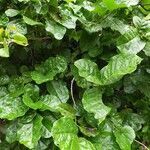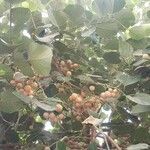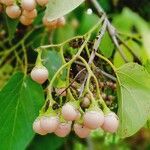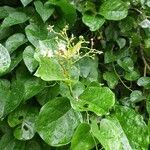Leaves alternate; petiole 1.5–4.5 cm. long, stout, glabrous or subglabrous; lamina 5–16 x 5–16 cm., broadly ovate to circular, glabrous or hairy only on the nerves above, pubescent to subglabrous but hairy at the axils below, rounded to shortly and obtusely acuminate at apex, obtuse to subcordate, rarely subacute at base, margins entire to slightly dentate or crenate-dentate, leathery, with 3–7 nerves from the base, the middle one with 3–5 secondary nerves on each side, net-veined.
A shrubby evergreen tree. It grows to 12 m high. The trunk can be 1-1.5 m wide. The leaves are broad and pointed and have teeth along the edges. The male and female flowers are white or cream and in loose panicles at the ends of branches. The fruit are small and nutlike. They are yellow, orange-pink or black. It has sweet, sticky flesh.
Fruit up to 30 mm. long, ovoid or globose, apiculate, glabrous, yellowish when ripe, surrounded at base by the widely enlarged campanulate calyx; pyrene c. 25 x 12 x 8 mm., more or less subwinged, 1–2-seeded.
Flowers variable, apparently all male but probably functionally unisexual and bisexual; buds 4–5 mm. long, obovoid, puberulous or pubescent on the upper part and sometimes brush-like at apex.
Ovary c. 3 mm. long, ellipsoid; style c. 8 mm. long in total length with stigmatic branches c. 5 mm. long, oblong, wide flattened with ± deeply toothed or lobed margins.
Corolla cream-coloured, glabrous; tube 3.5–6.5 mm. long, cylindrical; lobes 4–6, 5–7 x 2.0–3.5 mm., elliptic to obovate, obtuse at apex, reflexed and ± coiled.
Cymes arranged in few-flowered lax terminal panicles, 3–8 cm. long, sometimes on short lateral branches; rhachis and branches glabrous or subglabrous.
Stamens inserted at the corolla-throat; filaments 1.5–3.5 mm. long, hairy at the base; anthers 1.8–2.0 mm. long, oblong-sagittate, sometimes sterile.
Calyx 5–8 mm. long, narrowly campanulate, irregularly 3–5-toothed, glabrous or subglabrous outside, densely pubescent inside.
Small tree up to 10 m. high with spreading crown and long glabrous or subglabrous young shoots; leaf scars very prominent.
A shrub or tree up to 40 ft. high with stout stem, nearly glabrous branchlets
Cream-white flowers 1/3 in. long in lax paniculate cymes.
Pending. See references in Bibliography.





